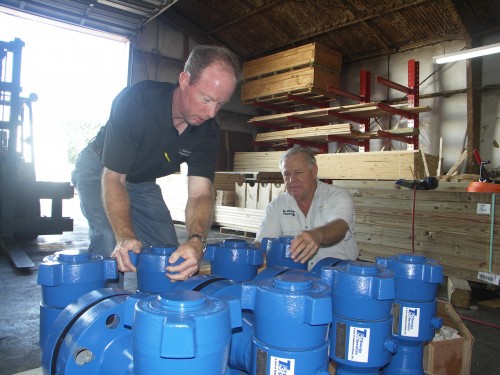
Packing and shipping outlet keeps business on the move
August 30, 2012Sports guy makes prep picks
August 30, 2012A: All-American – This is what every local is striving to be – the best in the country at what they do. Very few reach this level of excellence, but our area does have its share, most notably Thibodaux’s Trovon Reed and Greg Robinson and Patterson’s Kenny Hilliard.
B: Blitz – The blitz is one of the more common defensive plays in the sport. This is a play when a defensive player not on the defensive line rushes the quarterback to try and overwhelm and/or outnumber offensive blockers.
C: Concession – This is one of the most important places in the stadium for football fans. Our local schools are loaded with delicious eateries. Always know the shortest route to get from Point A to Point B when the belly starts rumblin’.
D: Dime – Don’t reach for loose change inside your pockets. Football’s version of this word is a defensive scheme in which two more defensive backs line up on the field in the place of linebackers to compensate for an opponent’s receivers. It is used primarily in passing situations.
E: End zone – The place where all of the glory is earned. This is where offensive teams try to march for the always-coveted six points. Likewise, this is the territory that defenses guard with their lives. The end zone is sacred territory amongst the football gods.
F: Fumble – Don’t look at your hometown coach when saying this term – it will likely cause his hair to lighten toward gray. A fumble is when an offensive player drops or loses control of the football. Once on the ground, the ball is free for either team. First person to possess it earns the ball for his team – a game-changer.
G: Going for it – The way football is structured, an offensive unit has four plays to earn 10 yards. But to be cautious, most teams punt and/or kick field goals on the fourth down. On the rare occasion where someone ‘goes for it,’ it means that the team will opt to try and get a first down instead of conceding possession via a kick. LSU coach Les Miles knows a thing or two about fourth-down magic.
H: Hang time – There are two keys to a good punt – distance and hang time. Distance is simple. It is the amount of yards the ball traveled from the line of scrimmage to its final destination. But hang time marks the amount of time the ball spent in the air. A long hang time allows the punt team critical seconds to get down the field to defend the return.
I: Icing the kicker – This has nothing to do with frozen water. The process of icing a kicker involves an attempt to throw him off his rhythm. Because kicking is such a rhythmic craft, coaches often believe that calling a timeout (especially before a big kick) will throw a kicker off his routine and force him to miss. Studies show the process doesn’t work, but coaches continue to utilize the craft.
J: Jelly legs – This is often the term given to a player after he receives a pad popping hit. After losing equilibrium because of the hit’s impact and force, the player collapses to the ground. After a few seconds to collect his thoughts, he gets up and readies himself for the next play.
K: Key – The word key in football is a term that is a synonym for ‘hint’ or ‘clue.’ Keys are tendencies that coaches find in other teams that often clue what is about to happen on a given play. For example, if an offensive tackle is lined up in a three-point stance, it may be a key that a play is a passing play compared to a run.
L: Lateral – The lateral occurs when a ball carrier pitches the ball behind him to another player to enhance the team’s chance to accumulate yardage. This could also occur on defense after a fumble recovery or interception or on a special teams return. The most famous local lateral came in 2007 when LSU holder Matt Flynn lateralled the ball to kicker Colt David who marched into the end zone for a touchdown against South Carolina.
M: Mike – Yes, Mike is the name of LSU’s beautiful Siberian Bengal tiger mascot. But in football, Mike is also a term for the middle linebacker in a 4-3 defensive alignment. The Mike is the jack of all trades within a defense – the player who makes most of the audibles.
N: Nickel – On the same line as dime, a nickel defense is a defensive scheme geared to defend the pass. Where the dime brings two extra defensive backs onto a field, the nickel is a defensive scheme where just one extra defensive back lines up on the field.
O: Offsides – Offsides is when a defensive player’s body crosses the line of scrimmage before a ball is snapped into play. If the infraction forces contact, a play is stopped. If contact isn’t made, a flag is thrown and the play continues until its completion. A five-yard penalty is charged to the defense guilty of the infraction.
P: Pistol – With spread offenses taking over the world of football, more fans are hearing the word ‘pistol’ when watching local action. This is a shotgun formation when the halfback is lined up directly behind the quarterback. It is usually a run-oriented formation.
Q: Quarterback – These are the guys who get all of the glory in the game. Most defensive players label these guys as pretty boys unable to take a hit. But the truth is that a quarterback’s responsibilities are a real mental challenge. These guys are the only players on the field who touch the ball on virtually every offensive play.
R: Red zone – The red zone is arguably the most important place on the entire football field. It is the area that marks the final 20 yards of grass before the end zone. Teams that score frequently in the red zone almost always succeed. Likewise, success almost always finds teams who defend the red zone with success.
S: Safety – Safety is our multi-purpose football term. The first (and most common) meaning is a defensive position that serves as the last line of defense on long passing plays. A safety is the player lined up deepest in the backfield and his job is to not let an offensive player get behind him. But safety can also mean a two-point score that occurs when a defense tackles an offense in their own end zone.
T: Touchback – A touchback is a special-teams situation when a kicker or punter boots the football into the opposing team’s end zone. Following a touchback, the ball is placed at the 20-yard-line and the new offensive team takes control of the ball.
U: Underdog – An underdog is a team that is not statistically favored to have success in a given game. They are teams that have nothing to lose and have everything to gain. No one in the stadium expects them to win the game, so they play purely on heart, hustle and pride. Underdogs are dangerous animals who can sometimes ruin another team’s victory party.
V: Victory formation – The victory formation is a word given to the alignment an offense takes when they are trying to run out the clock before the end of a game. With two players behind the quarterback serving as ‘offensive safeties,’ the quarterback takes the snap and immediately drops to a knee. This is done to run out the clock.
W: Wildcat – The Wildcat package is a package in which a quarterback either leaves the field or lines up at wide receiver for a play, leaving just a running back in the backfield. The halfback takes the snap and has the option to either run or throw the ball – a headache for defense. This was made famous by Arkansas and halfback Darren McFadden.
X: X-receiver – The X-receiver is the receiver that is commonly referred to as the split end. They line up on the line of scrimmage and are most often found on the opposite side of the field as the tight end. They often are bigger, taller receivers who go across the middle of the field to make receptions.
Y: Y-receiver – The Y-receiver is the third option in a pass play. They are often known as the slot receiver. These players often line up on the same side as the X-receiver, but they are aligned behind the line of scrimmage. These players are often smaller, but quicker than X-receivers.
Z: Z-receiver – The Z-receiver is the second option in a passing skeleton. They are aligned on the exact opposite end of the field from the X-receiver, but are kept off the line of scrimmage in most plays. That is done to avoid press coverage from opponents.









